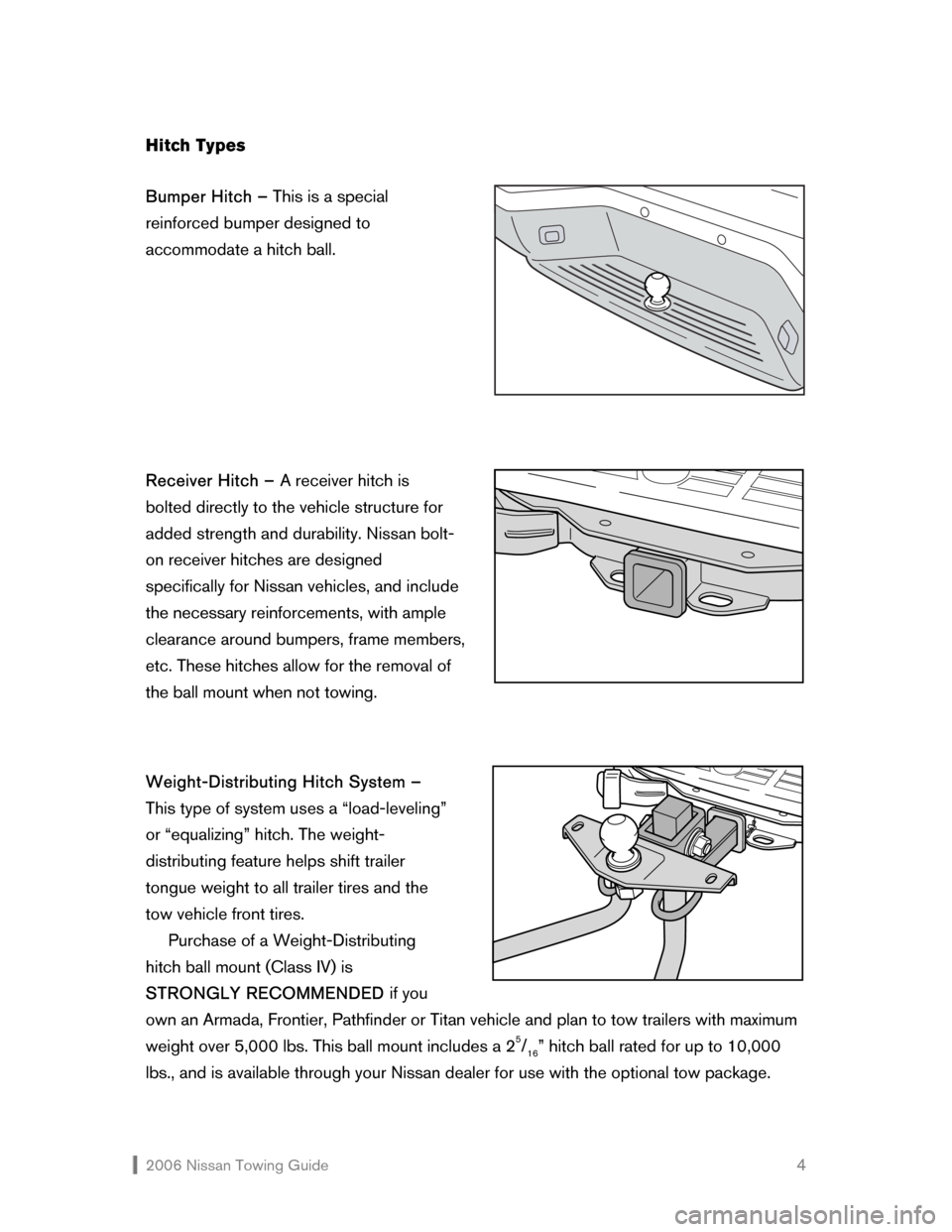tire type NISSAN MAXIMA 2006 A34 / 6.G Towing Guide
[x] Cancel search | Manufacturer: NISSAN, Model Year: 2006, Model line: MAXIMA, Model: NISSAN MAXIMA 2006 A34 / 6.GPages: 28, PDF Size: 2.12 MB
Page 2 of 28

2006 Nissan Towing Guide 1
INTRODUCTION
SAFETY IS PRIORITY ONE
Obviously, your first concern should be safety. Your vehicle was designed to be used
primarily to carry passengers and cargo. Always remember that towing a trailer places
additional loads on your vehicle’s engine, drivetrain, steering, braking, and other systems.
Therefore, be certain that your vehicle can meet the demands of the towing application you
have in mind.
Rent or purchase only the highest-quality towing and safety equipment you can find.
Reinforced tow hitches designed especially for certain Nissan vehicles are available from
your Nissan dealer.* Hitches for the other Nissan models should be bought from and
installed by a professional supplier of towing equipment. Finally, it is important to follow the
towing capacity limit set for your specific vehicle, and to ensure that your vehicle is in top
mechanical condition; especially the tires, brakes, suspension, and engine cooling system.
See your owner’s manual for details.
NEVER EXCEED THE ESTABLISHED TOWING CAPACITY
Towing capacities vary from vehicle to vehicle. See the SPECIFICATIONS section of this
guide to view the towing capacities of 2006 Nissan vehicles produced at the time of
Towing Guide publication. Use this data to help select the proper Nissan vehicle to meet
your anticipated needs, and refer to it when renting a trailer or other piece of towing
equipment.
EQUIP YOUR NISSAN FOR TOWING
The frequency and type of towing should also influence the manner in which you equip
your vehicle. If you plan to tow often, either for recreation or work, select the engine size,
transmission type, suspension, and towing capacity that are best suited to your
requirements. This guide can help you select that equipment.
If, on the other hand, your towing will be infrequent, choose the Nissan vehicle and
equipment that best meets your day-to-day needs. Then, be careful not to exceed the
towing capacity on those few occasions when you do tow.
READ THIS GUIDE BEFORE YOU TOW
This guide was designed to provide an overview of safe towing practices. In it you’ll find
information on towing equipment, safety, proper loading and driving techniques, towing tips,
and much more.
It is also a good idea to discuss your towing requirements with either your Nissan dealer
or a professional supplier of towing equipment before you equip your Nissan vehicle for
towing. Finally, there are state and local laws on towing that you should review to ensure
you comply with all regulations.
*Quest tow hitch is factory installed only.
Page 3 of 28

2006 Nissan Towing Guide 2
TOWING
EQUIPMENT
RENTING
The first thing to keep in mind when renting a trailer is to rent only from professional
companies that specialize in towing and towing equipment. More than likely, these
representatives will have some experience in selecting and fitting the towing equipment
that is appropriate for your Nissan vehicle.
When renting, make sure you have your owner’s manual on hand so that you can check
the towing capacities for your specific vehicle. Never rent a trailer that exceeds these
capacities, and make sure that any other equipment you rent is sufficient for your loaded
trailer.
While you’re there, ask questions: How much does the trailer weigh? What is the trailer
tongue load? How much weight will the trailer hold? What type of brakes is it equipped
with? All of these items have an effect on whether your Nissan vehicle is capable of safely
pulling that trailer or piece of equipment.
Make certain that all trailer stoplights, taillights, and turn signals are hooked up and
operate correctly, and that all safety equipment is properly installed. Check the safety
chains/cables, tie-downs, etc.
Carefully inspect the condition of the trailer and equipment. Are the tires worn
excessively? Are the tire pressures correct? Are there broken welds, missing bolts or
pieces? All these factors can also affect your safety.
Towing safety should be a high priority when choosing and renting equipment, and this
is especially true concerning hitches. Never rent a clamp-on-type hitch. Since Nissan
bumpers not specifically marked for towing are not designed for trailer loads, using this
type of hitch may cause damage to your vehicle and could result in trailer separation during
towing. Tow only with a permanent-type hitch.
PURCHASING
Purchase towing items such as hitches and hitch balls only from your Nissan dealer or a
professional supplier of towing equipment.
If you are intending to use your vehicle to tow a trailer you already own, first determine
the trailer’s weight when fully loaded. This will tell you if, in fact, your vehicle is capable of
pulling this amount of weight. In addition, it will also help you purchase the right type, style,
and class* of hitch and other equipment.
*See the SPECIFICATIONS section of this guide for equipment class information specific to your
vehicle.
Page 4 of 28

2006 Nissan Towing Guide 3 If you are buying a travel or boat trailer, be sure that your Nissan vehicle has the towing
capacity to pull it. See the SPECIFICATIONS section of this guide, or refer to your owner’s
manual for detailed information regarding the towing capacity of your specific vehicle. Your
owner’s manual should ALWAYS be referenced before making any towing decisions.
Naturally, you’ll want to buy the highest-quality equipment you can find for maximum
towing safety. And if you plan to tow often, consider convenience. Quick-disconnect trailer
light connectors and ratchet-type tie-downs, for example, make the job go faster and easier,
and are usually worth the small extra investment.
WHAT’S
RIGHT FOR YOU
TYPES OF EQUIPMENT
Towing requires a variety of equipment, and, depending upon the application, there can be
several types or styles of each piece of equipment. Working with your Nissan dealer or a
professional supplier of towing equipment, it should be relatively simple to determine the
proper type of equipment for your specific vehicle given the intended application. This
section explains the most common pieces of towing equipment available.
HITCHES
Whichever type of hitch you use, it should be firmly bolted to your vehicle, and should be of
the appropriate weight class for the equipment you intend to tow. In addition, keep the
following in mind:
�Š Do not modify the vehicle’s braking or exhaust systems or its body structure/frame when
installing the hitch.
�Š Be sure that the hitch does not interfere in any way with the vehicle’s energy-absorbing
bumper.
�Š Regularly check to see that all hitch-mounting bolts are securely fastened.
�Š Where practical, remove the hitch when not in use. Your Nissan dealer can assist you in
hitch removal and reinstallation. When removed, seal the bolt holes to prevent road
spray, fumes, water, and dirt from entering the vehicle.
�Š For receiver-type hitches using a ball mount, the ball mount should be removed when
not towing.
�Š If you install a hitch yourself, remember that it must be securely attached to the frame or
underbody, according to the manufacturer’s instructions. Never attach a hitch or
towing device to the vehicle axle housing. This may damage the housing, wheel
bearings, wheels, or tires.
Page 5 of 28

2006 Nissan Towing Guide 4 Hitch Types
Bumper Hitch – This is a special
reinforced bumper designed to
accommodate a hitch ball.
Receiver Hitch – A receiver hitch is
bolted directly to the vehicle structure for
added strength and durability. Nissan bolt-
on receiver hitches are designed
specifically for Nissan vehicles, and include
the necessary reinforcements, with ample
clearance around bumpers, frame members,
etc. These hitches allow for the removal of
the ball mount when not towing.
Weight-Distributing Hitch System –
This type of system uses a “load-leveling”
or “equalizing” hitch. The weight-
distributing feature helps shift trailer
tongue weight to all trailer tires and the
tow vehicle front tires.
Purchase of a Weight-Distributing
hitch ball mount (Class IV) is
STRONGLY RECOMMENDED if you
own an Armada, Frontier, Pathfinder or Titan vehicle and plan to tow trailers with maximum
weight over 5,000 lbs. This ball mount includes a 2
5/16” hitch ball rated for up to 10,000
lbs., and is available through your Nissan dealer for use with the optional tow package.
Page 22 of 28

2006 Nissan Towing Guide 21
TOWING
GLOSSARY
5TH WHEEL
HITCH Located just forward of the rear axle centerline, this hitch uses a king pin to serve
as the pivot point for the trailer.
BALL MOUNT A bar that holds the hitch ball and is inserted into the hitch receiver. Also
commonly called a drawbar or “stinger.”
BREAKAWAY SWITCH A safety device using a trailer battery that automatically applies the trailer’s
brakes if it should accidentally become separated from the tow vehicle. A
breakaway switch may be used with both electric or surge trailer brake systems.
BUMPER HITCH A reinforced bumper designed to accommodate a hitch ball.
ELECTRIC TRAILER
BRAKES When the brakes on a tow vehicle are applied, an electric current is sent to an
actuator which applies the trailer’s brakes.
ELECTRIC TRAILER
BRAKE CONTROLLER A device that controls the electric trailer brakes.
GOOSENECK HITCH Located just forward of the rear axle centerline, this hitch uses a ball to serve as
the pivot point for the trailer.
GROSS AXLE
WEIGHT RATING (GAWR) The maximum amount of weight each vehicle axle (front and rear) is designed to
safely carry.
GROSS COMBINED
WEIGHT RATING (GCWR) The maximum allowable combined weight of the vehicle and trailer, including
passengers and all cargo.
GROSS VEHICLE
WEIGHT RATING (GVWR) The maximum allowable weight of the vehicle, including passengers, cargo, fuel,
hitch, trailer tongue load, and any optional equipment.
KING PIN
LOAD The amount of trailer (5th wheel or gooseneck) weight pressing down on the tow
vehicle hitch.
HITCH BALL
A ball that connects the trailer to the tow vehicle hitch and provides the means
by which the trailer pivots during cornering. Available in a number of sizes and
weight capacities, it must correspond to the trailer coupler size, and have a
sufficient capacity rating for the trailer being pulled.
RECEIVER HITCH A frame- or structure-mounted hitch with a receiver that allows removal of the
ball mount.
SAFETY CHAINS/CABLES Provides an emergency connection between the tow vehicle and the trailer,
should the trailer become disengaged for any reason.
SURGE BRAKES
Hydraulic-type braking system activated by inertia. As the tow vehicle begins to
brake, the trailer pushes against the hitch ball, consequently activating the trailer
brakes.
TRAILER TONGUE/COUPLER The part of the trailer that extends forward to meet the tow vehicle, and also
carries the coupler assembly.
TRAILER TONGUE
LOAD The amount of trailer (conventional) weight pressing down on the tow vehicle
hitch.
WEIGHT-DISTRIBUTING HITCH
SYSTEM Type of hitch system that helps shift the trailer tongue weight to all trailer tires
and the tow vehicle front tires. Strongly recommended when towing trailers with
a Maximum Trailer Weight greater than 5,000 lbs.
WIRING HARNESS
Provides an electrical connection linking the tow vehicle’s electrical system to
the trailer’s system.